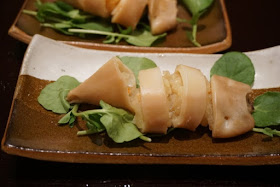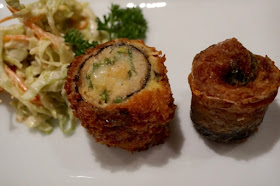Every year, my wife bakes some kind of hot cross buns as Easter approaches. Among the several she's baked over the years, this one is the best so far. This is based on a
recipe from King Arthur Flour. She is also into "Seasonal" decorations and, besides a collection of numerous Easter eggs and "bunnies", she also recently got two sets of Easter plates and her hot cross buns were served on one of the "bunny" plates.
According to my wife, this is her favorite bunny plate. I will let my wife take over.
Ingredients (18 rolls):
- 1/4 cup rum
- 1/2 cup raisins
- 1/2 cup cherry infused craisins
- 1/2 cup pomegranate infused craisins
- 1 1/4 cups milk, room temperature
- 3 large eggs, 1 separated
- 6 tablespoons butter, room temperature
- 2 teaspoons instant yeast (one packet)
- 1/4 cup light brown sugar, firmly packed (we used regular sugar and 1 tbs of molasses)
- 1 teaspoon ground cinnamon
- 1/4 teaspoon ground cloves
- 1/4 teaspoon ground nutmeg
- zest of 2 lemons
- 1 3/4 teaspoons salt
- 1 tablespoon baking powder
- 4 1/2 cups All-Purpose Flour (plus more as needed)
For glaze: (I forgot to put the glaze on)
- 1 large egg white, reserved from above
- 1 tablespoon milk
For icing:
- 1 cup + 2 tablespoons confectioners' sugar
- 1/2 teaspoon vanilla extract
- pinch of salt
- 4 teaspoons milk, or enough to make a thick, pipeable icing
Directions:
1) Generously grease a large pyrex pan (10" square pan or 9" x 13").
2) Mix the rum with the dried fruit and raisins, cover and microwave briefly, just until the fruit and liquid are very warm. Set aside to cool to room temperature. (By-the-way I did not intend to use so many crasins but the labeling on the package was a bit confusing. In large red letters it said "cherry" and "pomegranate" and in much smaller dark blue letters "crasins". I thought I was adding dried cherries and dried pomegranates--but the crasins worked out).
3) I put 4 cups of all purpose flour in the bowl of the mixer added the cinnamon, cloves, nutmeg, salt and baking powder and stirred to mix into the flour. With the mixer running I added the proofed yeast (proofed in 1/4 cup warm water with some sugar added and dissolved), and milk (with lemon zest added) until blended . Then I added the two eggs and one yolk one at a time until blended (#1). At this point the dough was quite sticky. So like any other type of bread I started adding flour 1/4 cup at a time until the dough could hold its shape even though it was still quite sticky. Then I added the butter a little at a time in pats and blended into the dough as it kneaded on the hook. When I reached what I thought was the right consistency I let it knead for 7 minutes. Then I started adding the fruit and let it knead an additional 3 minutes. (I have found that it is easier to let any butter and fruit added to a bread recipe to be kneaded into the bread in the mixer with the dough hook than tring to do it by hand). Picture #2 shows what the dough looked like when it came out of the mixer. I hand kneaded it a few times until the surface became smooth (#3). I put it into a bowl that had been warmed with hot water and dried. I added some vegetable oil and coated the dough so it wouldn't dry out while rising.
4) I let the dough rise for about 1 hour, covered. It didn't completely double in size but it was quite puffy (#4).
5) I divided the dough into balls 3 ounces each and put them in the prepared pan (#5).
6) I let the buns rise for about 1 hour, or until they were touching one another and preheated the oven to 375°F.
7) Although I forgot to do this, whisk together the reserved egg white and milk, and brush it over the buns. (I think the buns are ok even without the glaze).
8) Bake the buns for 18 to 20 minutes, until they're golden brown. Remove from the oven, and transfer to a rack immediately to cool (#6).
9) Before serving and after the buns have cooled I mixed together the icing ingredients, and piped the icing in a cross on top of each bun.
These were extremely good. They had a rich soft texture and lots of flavor from the spices, rum and fruit. I do have to say that with all those good flavors I really didn't notice the lemon zest and may leave it out next time. While in general I don't like icing because it is too sweet, the icing in this case added a nice flavor dimension that otherwise would have been missed. I think this will become our go-to hot cross bun recipe in future years. It is really a treat to wake up to these buns slightly warmed with a cup of cappuccino --especially when served on an Easter bunny plate.












































